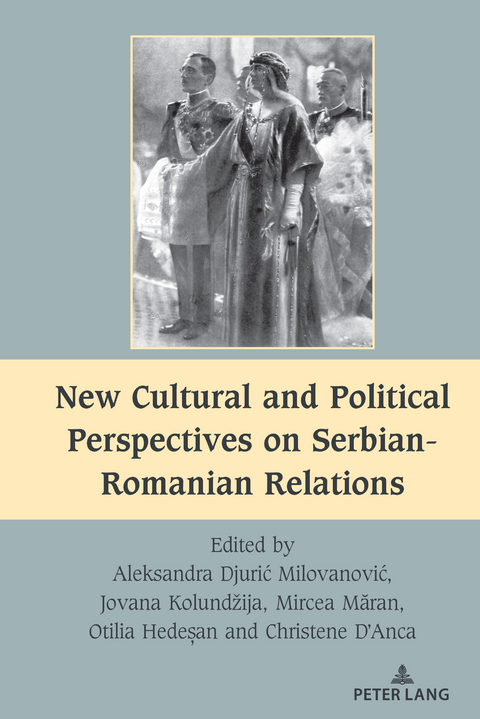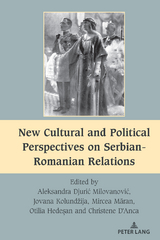New Cultural and Political Perspectives on Serbian-Romanian Relations
Peter Lang Publishing Inc (Verlag)
978-1-63667-034-8 (ISBN)
lt;p>This unique interdisciplinary volume explores the complex history of cultural, diplomatic and religious relations between Serbia and Romania during the late nineteenth and twentieth century. The authors, scholars with a wide range of academic backgrounds, address these themes in the context of Austro-Hungarian imperialism, the interwar period and the Communist era. The essays in Part I examine diplomatic, political and military relations, while those in Part II explore intellectual and artistic links between the two countries, including religion, literature and the visual arts.
This is a landmark publication, the first of its kind in English, and will leave readers with a more comprehensive understanding of cultural and political relations in Southeastern Europe.
Aleksandra Djurić Milovanović is an anthropologist and senior research fellow at the Institute for Balkan Studies, Serbian Academy of Sciences and Arts (Belgrade, Serbia). She received her PhD from the Faculty of Philosophy in Belgrade in 2012. Her research interests cover Serbian-Romanian relations, religious minorities, national minorities, cultural transfers and Balkan studies. Representative publications include: Double Minorities in Serbia. Distinctive Aspects of Religion and Ethnicity of Romanians in Vojvodina (2015) and Orthodox Christian Renewal Movements in Eastern Europe, co-edited with Radmila Radić (2017). She is a member of the Balkan History Association. Jovana Kolundžija is art historian and PhD candidate at the University of Belgrade, She has been a research fellow at the Institute for Balkan Studies SASA and is currently affiliated with the Center for Banat Studies as project coordinator. Her research includes eighteenth-century Serbian art, religious painting, Serbian baroque, visual culture and Habsburg heritage in Serbia. She is a member of the Balkan History Association. Mircea Măran is a full professor of history at the Preschool Teacher training college "Mihailo Palov" in Vršac, Serbia. Măran’s main area of interest are the history of Banat, the Romanian minority in Serbia and cultural history between the two world wars. He is the author of 12 books, Representative titles include: Romanii din Banatul sârbesc în anii interbelici (1918–1941) pagini de istorie culturală (2012), Biserica Ortodoxă română din Banatul Iugoslav (1918–1941) with A. Djurić Milovanović (2019) and Românii din Voivodina – istorie, demografie, identitate românească în localitățile Voivodinei (2009). He is a member of the Balkan History Association. Otilia Hedeșan is an anthropologist and professor of Romanian civilization and culture at the West University of Timișoara. She is the coordinator of the Research Centre for Heritage and Anthropology. Her main areas of research are storytelling, Romanian mythology in its contemporary aspects, the history of Romanian ethnology in the communist and post-communist period, and food as cultural heritage. She has undertaken field research in Romania, Serbia, Hungary, Croatia, Bulgaria, Ukraine and the Republic of Moldova. She has written and edited many books and articles. Christene D’Anca is a lecturer at California Lutheran University, as well as at her alma mater, the University of California, Santa Barbara, where she received her PhD in comparative literature, with an emphasis in medieval studies. She specializes in twelfth- to fourteenth-century funerary arts, female patronage and socio-cultural studies. Her recent publications include essays in Early Middle English and the Journal of Animal Ethics.
lt;p>Table of Contents
Acknowledgment
Introduction: New Cultural and Political Perspectives on Serbian-Romanian Relations Aleksandra Djuric Milovanovic, Mircea Maran, Christene D'Anca *
Part I Serbian-Romanian Relations - Historical and Diplomatic contexts The Idea of Nationality among Romanians in the Austro-Hungarian Monarchy: The Political Involvement of Vincen iu Babe , Andrei, and Alexandru Mocsonyi as Representatives of the Banat Region, Miodrag Milin, Victor Neumann *
Romanians and Serbs in the Banat Military Border, Ivana Spasovic *
Romanian-Serbian Relations Reflected in Vasile Popeanga's Works. Historiographical Insight, Felicia Aneta Oarcea *
Bosko Colak-Antic and Yugoslav-Romanian Relations, Sr an Micic *
Maria of Yugoslavia: Romanian Princess, Yugoslav Queen, An elija Miladinovic *
The First Yugoslav Ambassador: Jovan Ducic in Romania, 1937-1940, Dragan Bakic *
Josip Broz Tito, Petru Groza and Yugoslav-Romanian Relations 1945-1947, Vladimir Lj. Cvetkovic *
Tito's and Ceausescu's Personal Contribution to the Development of Yugoslav-Romanian Cooperation in the Late 1960s and Early 1970s, Nemanja Mitrovic *
Part II Serbian-Romanian Relations - Cultural, Artistic and Religious Studies Perspective The Circulation of Icon Painters between Banat and Transylvania during the Eighteenth and Early Nineteenth Centuries, Raluca Prelipceanu *
Stefan Tenecki: the Baroque Painter of Serbs and Romanians, Jovana Koludzija *
Serbian Intellectuals from Arad, Personalities of Central Europe, Maria Alexandra Pantea, Virginia Popovic *
Vladimir Dimitrijevic and Serbian-Romanian Church Relations in the Late Nineteenth and Early Twentieth Centuries, Mircea Maran, Aleksandra Djuric Milovanovic *
Romanian-Serbian Literary Relations at the Begining of the Millennium, Octavia Nedelcu Gordana-Nicoleta Peici *
In-between Local Identity and National Artistic Heritage. A Case Study: Naïve Painting from Uzdin, Diana Mihu *
Index, Jovana Kolundzija *
This volume, the first of its kind, covers political diplomatic,cultural and religious relations between the Romania and Serbia, seen through the processes that shaped the two nations over the past two centuries, but also through case studies of prominent diplomats, educators, artists, rulers and statesmen. The result is a comprehensive survey of Romanian-Serbian relations based on serious archival research, leading to new and more inclusive perspectives. I am quite convinced that the collection will become a standard guide for all those interested in the relations between Serbs and Romanians. Prof. Slobodan G. Markovich, University of Belgrade Historically, relations between neighboring nations and the people who populated them, have at various points been plagued by conflict. Yet it is difficult to cast complete blame on either side as it can be surmised that the actions taken were a result of people subject to their times. However, aside from confrontations, neighboring states also cooperated, fought together in the interest of common values, against invaders, while they also intermarried, thus enhancing both cultures. The present volume is a successful attempt by Romanian and Serbian specialists to find the political-diplomatic, cultural, and artistic interferences, that amounted to the elements of cooperation between Romanians and Serbs in the last centuries. Such instances of alliance, far from few in number, certainly prevailed in the history of the two nations, and they shaped the destiny of Romania and Serbia into the modern and contemporary eras. Prof. dr Ioan Bolovan, Institutul de Istorie "George Barit" Cluj-Napoca and University Babe -Bolyai Cluj-Napoca
"This volume, the first of its kind, covers political diplomatic, cultural and religious relations between the Romania and Serbia, seen through the processes that shaped the two nations over the past two centuries, but also through case studies of prominent diplomats, educators, artists, rulers and statesmen. The result is a comprehensive survey of Romanian-Serbian relations based on serious archival research, leading to new and more inclusive perspectives. I am quite convinced that the collection will become a standard guide for all those interested in the relations between Serbs and Romanians."
—Prof. Slobodan G. Markovich, University of Belgrade
"Historically, relations between neighboring nations and the people who populated them, have at various points been plagued by conflict. Yet it is difficult to cast complete blame on either side as it can be surmised that the actions taken were a result of people subject to their times. However, aside from confrontations, neighboring states also cooperated, fought together in the interest of common values, against invaders, while they also intermarried, thus enhancing both cultures. The present volume is a successful attempt by Romanian and Serbian specialists to find the political-diplomatic, cultural, and artistic interferences, that amounted to the elements of cooperation between Romanians and Serbs in the last centuries. Such instances of alliance, far from few in number, certainly prevailed in the history of the two nations, and they shaped the destiny of Romania and Serbia into the modern and contemporary eras."
—Prof. dr Ioan Bolovan, Institutul de Istorie “George Bariţ” Cluj-Napoca and University Babeș-Bolyai Cluj-Napoca
| Erscheinungsdatum | 08.08.2023 |
|---|---|
| Reihe/Serie | South-East European History ; 10 |
| Mitarbeit |
Herausgeber (Serie): Mihai Dragnea |
| Verlagsort | New York |
| Sprache | englisch |
| Maße | 150 x 225 mm |
| Gewicht | 617 g |
| Themenwelt | Kunst / Musik / Theater |
| Geisteswissenschaften ► Geschichte | |
| Sozialwissenschaften ► Politik / Verwaltung ► Europäische / Internationale Politik | |
| Schlagworte | Aleksandra • Aleksandra Djuric Milovanovic • Art History • Christene • Christene D' Anca • Cultural • Cultural transfer • culture, political history • D'Anca • Diplomacy • Djuric • Dragnea • Dunshea • Hede an • influences • Jovana • Jovana Kolundzija • Kolundzija • Maran • mihai • Milovanovic • Mircea • Mircea Maran • New Cultural and Political Perspectives on Serbian-Romanian Relations • Otilia • Otilia Hede an • Personalities • Perspectives • Philip • Political • Relations • Religion • romanian • serbian • Serbian-romanian relations • Southeastern Europe |
| ISBN-10 | 1-63667-034-2 / 1636670342 |
| ISBN-13 | 978-1-63667-034-8 / 9781636670348 |
| Zustand | Neuware |
| Informationen gemäß Produktsicherheitsverordnung (GPSR) | |
| Haben Sie eine Frage zum Produkt? |
aus dem Bereich




